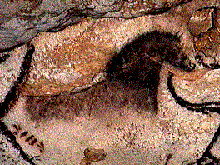 Black mold threatening the prehistoric Lascaux cave drawings in southwestern France was the topic of discussion in Paris last week, where a panel of specialists met to discuss the problem.
Black mold threatening the prehistoric Lascaux cave drawings in southwestern France was the topic of discussion in Paris last week, where a panel of specialists met to discuss the problem.
Discovered in 1940 and referred to as “the Sistine Chapel of prehistory,” Lascaux cave’s walls and ceiling are covered with murals of horses, bulls and other creatures painted between 15,000 and 20,000 years ago. Of 605 pictures that can be identified as specific animals, 364 are of equines, many highly detailed, often shown in action alongside cattle and other animals.
In 1955, carbon dioxide produced by an average of 1,200 visitors a day had already begun to damage the Lascaux paintings. The cave was permanently closed to the public in 1963, to prevent further deterioration.
Following the installation of a new air-conditioning system in 2001, problems with mold first appeared in the form of a white fungus that was successfully retarded with fungicides and antibiotics. In 2008, when black mold began to appear, France was criticized by conservationists for its handling of the situation.
“The black spots are not shrinking nor are they progressing,” Marc Gauthier, head of the cave’s scientific committee, told journalists last Friday. “The cave is sick and is currently resting. We want the patient to recover and restore its natural balance by itself.”
The seminar’s chairman, Jean Clottes, said the microscopic flora in Lascaux is “fiendishly” complex.
“A hundred micro-organisms or more are cohabiting and interacting there,” he explained. “All it needs is for one to dominate for disaster to ensue.”
